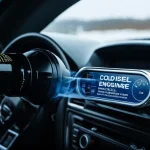Protecting Your Adaptive Cruise Control Sensors in Winter
Ensuring sensor functionality in cold conditions
Winter demands extra attention to protecting adaptive cruise control sensors. These sensors, often positioned on the grille or bumper, are vulnerable to snow, ice, and road salt buildup. If blocked or impaired, the adaptive cruise control system struggles to detect vehicles ahead accurately, leading to reduced performance or temporary deactivation.
Also to read : Comprehensive guide: essential techniques for inspecting steering fluid in high-mileage cars to avoid system failures
To prevent this, regular winter vehicle maintenance should include clearing sensors of debris. Use a soft cloth and warm water or automotive-safe de-icer sprays to gently remove ice or snow. Avoid harsh scrubbing or chemicals that can damage sensor lenses.
Ignoring sensor care can cause false readings or interruptions, compromising the safety and reliability of your adaptive cruise control. Sensor blockage may trigger warning lights or force drivers to disengage the system manually.
Also read : Enhancing minivan airbag performance: key tactics for maximum safety and protection
Implementing simple routines such as inspecting sensors before driving, parking in sheltered areas, and cleaning after exposure to salt improves sensor function. These steps are critical for sensor care and help maintain consistent adaptive cruise control responsiveness throughout winter conditions.
Step-by-Step Cleaning and Maintenance Tips
Maintaining adaptive cruise control sensors is vital, especially in winter when snow, ice, and salt can obstruct them. To clean these sensors safely, avoid abrasive materials that may scratch the lens. Instead, use a soft microfiber cloth dampened with water or a mild, non-abrasive detergent. Gently wipe the sensor surface to remove dirt and debris without applying excessive pressure.
For winter cleaning tips, it’s effective to use automotive-approved de-icing sprays designed not to damage sensor components. Avoid household chemicals or solvents, as they can degrade sensor coatings or plastic parts. Applying these products after parking and allowing them a few minutes to work before wiping helps clear ice buildup safely.
Sensor maintenance also includes regular inspections. It’s recommended to check your car’s sensors weekly during harsh weather or after long trips in snowy conditions. Look for dirt accumulation or ice that could impair sensor performance. Frequent cleaning ensures optimal functionality of adaptive cruise control systems, helping maintain vehicle safety and performance on icy roads.
By adopting these sensor maintenance habits, you preserve sensor clarity and avoid costly repairs. Regular care keeps technology responsive, particularly during winter’s challenges.
Recommended Products and Sensor Covers
Protect your sensors with the best winter car protection products
When considering adaptive cruise control sensor covers, it’s essential to choose products designed specifically for your vehicle’s make and model. These covers act as shields, preventing snow, ice, and road salt from obstructing sensors. This protection maintains reliable sensor performance and helps you avoid costly repairs.
Several top-rated winter car protection products stand out for their durability and ease of installation. For example, silicon-based sensor covers offer flexibility and excellent resistance to cold weather. Hard plastic shields provide robust protection but may require precise fitting. Both types can significantly reduce sensor blind spots caused by winter debris.
To select the best products for sensors, prioritize compatibility. Check the dimensions and mounting methods to ensure secure attachment. Some covers also include anti-fog coatings, enhancing sensor clarity during moisture changes. Investing in these accessories not only extends sensor life but ensures your car’s adaptive cruise control system functions safely in harsh conditions.
Always verify product reviews and confirm whether installation requires professional assistance. The right sensor cover can enhance your vehicle’s reliability through winter’s challenges.
Avoiding Common Mistakes When Protecting Sensors
Key to maintaining sensor efficiency and safety
Protecting vehicle sensors involves avoiding common sensor protection mistakes that can cause damage or malfunction. One frequent error is using harsh or abrasive cleaning materials. Such substances can scratch or degrade sensor lenses, leading to false readings or failure. Instead, opt for gentle, sensor-friendly cleaning solutions recommended by manufacturers.
During winter driving, errors multiply. Drivers often neglect to clear ice and snow adequately, leaving sensors blocked. This causes misinterpretation of the environment, directly impairing systems like adaptive cruise control. For instance, snow buildup may cause the system to slow unnecessarily or fail to detect obstacles.
Another sensor care mistake is relying on high-pressure washers. These can force water into sensor housings and damage internal electronics, reducing the reliability and lifespan of these components.
Misuse of sensors impacts adaptive cruise control safety by reducing its ability to maintain proper distance or respond to traffic changes. Precise sensor function is essential for real-time environment assessment, and errors in care increase the risk of accidents.
Proper maintenance requires regular, careful cleaning and avoiding shortcuts that jeopardize sensor integrity. Understanding these pitfalls helps ensure sensors perform reliably in all conditions.
Troubleshooting and Winter-Specific ACC Issues
Understanding how winter affects ACC can save you time and improve safety
Winter driving sensor problems are common and can severely impact the effectiveness of adaptive cruise control (ACC). One clear sign of sensor blockage or malfunction is when the ACC system fails to maintain consistent speed or distance from vehicles ahead. You may notice sudden braking or the system deactivating unexpectedly.
For basic troubleshooting, start by inspecting the vehicle’s radar and camera sensors for snow, ice, or dirt accumulation. Gently cleaning these sensors with a soft cloth can often restore functionality. Additionally, cold temperatures can cause temporary sensor glitches, so allowing the car to warm up before driving might help.
If issues persist despite these care steps, consult your vehicle’s manual for specific diagnostics or error codes related to ACC. Persistent malfunctions during winter could indicate deeper sensor damage or calibration needs, necessitating professional attention. Certified technicians have the tools to recalibrate or replace sensors, ensuring your adaptive cruise control system functions reliably in all conditions.
Following these ACC winter tips helps maintain your system’s safety features and reduces frustration during cold months.


